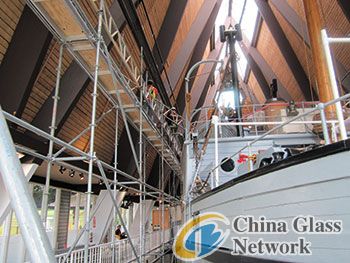Post Time:Oct 23,2012Classify:Glass QuotationView:613
 Almost 50 years after they were first installed, the skylights in the Vancouver Maritime Museum (VMM), which houses the iconic RCMP schooner St. Roch, are being replaced.
Almost 50 years after they were first installed, the skylights in the Vancouver Maritime Museum (VMM), which houses the iconic RCMP schooner St. Roch, are being replaced.
The project hit a snag, but the job’s design consultant came up with a creative solution.
When the A-frame building in Vanier Park began leaking, building owner City of Vancouver hired Pacific Building Envelopment Maintenance Ltd (PBEM) of Delta, B.C. as the prime contractor to replace the skylights.
“If the leaking wasn’t stopped, it could lead to water damage, causing dry rot and mould,” said museum curator Patricia Owen.
The skylights that are being replaced are located 50 feet above the floor of the building.
PBEM project manager Adrian di Piazza said the old skylights are made of two pieces of glass in each of 68 openings in the building’s roof.
Each skylight panel is about nine feet tall and three feet wide. In addition to the glass, the frames are also being replaced.
The original skylights were made of single-pane GPW (Georgian Polished Wire) glass, while the new versions are one-inch thick insulated units which weigh about five times more than the ones they are replacing.
The skylight panels are supplied and installed by Rutland Glass Ltd.
The A-frame structure meant that contractor Matakana Scaffolding Inc. couldn’t erect scaffolding on the outside of the building, but had to build it inside.
“Matakana installed the scaffolding up, around and over the boat, without touching it,” di Piazza said.
“On top of the scaffold, at the base of the skylight level, there’s a deck that protects the boat from dirt and debris. We treat the boat like the Mona Lisa and work around it very, very carefully.”
It took a total of three weeks to erect the scaffold.
The Rutland Glass crew is working from a zoom boom outside the museum.
They can replace the skylights on one side of the building without much difficulty because there is a parking lot on that side from which their vehicle can work.
But, there is limited access to the other side of the building and the zoom boom must be at the north and south ends of the structure for the crews to get at that side.
The project was further complicated by the discovery by the Vancouver office of the IRC Group, the project’s design authority, of 10 wood beams that were splitting.
Di Piazza said that replacing the beams would have pushed the project into the rainy winter months.
“We would have had to take off the top of the building to replace the beams and the boat would have got wet,” he said.
“Instead, the design consultant strengthened the beams and we’re replacing the skylights one after the other, so the boat is protected.”
IRC’s Ana Gutierrez said the problems caused by the beams, which rest on a main supporting beam, are not structural.
“In order to prevent further splitting of the beams, we reinforced them by installing approximately 200 half-inch steel plate brackets along their length,” she said.
Because no moisture is allowed on the St. Roch, the contractors are working within a narrow weather window.
“We can work on only dry days,” di Piazza said.
“We check the weather forecast days ahead of time.”
PBEM even had to shut down the sprinkler system for the duration of the project, so as not to set it off accidentally and get the boat wet.
As a result, the project has a fire watch in place. Work on the roughly $600,000 project began in August.
It is expected to be completed by the end of October, only one month past the original deadline.
The St. Roch is notable for being the first vessel to sail the Northwest Passage from east to west between 1940 and 1942.
The St. Roch is a little more than 100 feet long and almost 25 feet wide, with a draft of slightly more than 10 feet.
The vessel is one of the main attractions of the museum, which receives about 65,000 visitors a year.
Source: www.journalofcommerce.comAuthor: shangyi